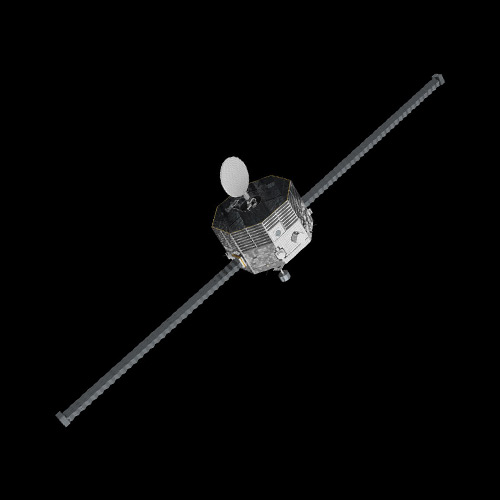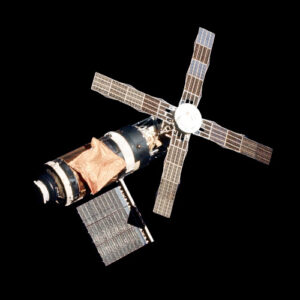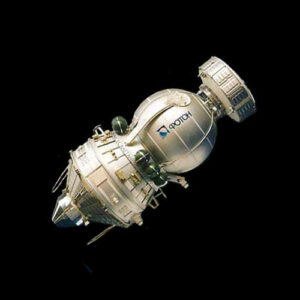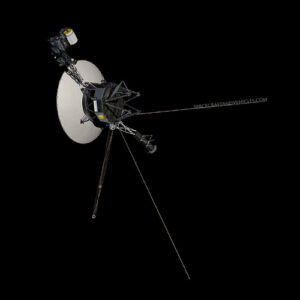The Mercury Magnetospheric Orbiter (MMO), also known as Mio, is part of the BepiColombo mission, a collaboration between the Japan Aerospace Exploration Agency (JAXA) and the European Space Agency (ESA). The MMO’s primary purpose is to study Mercury‘s magnetosphere, providing insights into the planet’s magnetic field, solar wind interactions, and space weather phenomena. Notable achievements of the MMO include its successful integration with the BepiColombo mission, the complex cruise phase involving multiple flybys, and the anticipated detailed study of Mercury’s magnetospheric dynamics upon arrival. The data collected by MMO will significantly enhance our understanding of Mercury’s space environment and contribute to comparative planetology.
Design and Construction
The Mercury Magnetospheric Orbiter is designed to withstand the harsh conditions of space and the intense solar radiation near Mercury. The spacecraft features a cylindrical design with a diameter of about 1 meter and a height of approximately 1.8 meters. This compact structure is optimized for both the cruise phase and operational phase around Mercury. The MMO is equipped with a variety of scientific instruments mounted externally to maximize their exposure to the space environment.
Constructed from lightweight yet durable materials, the MMO’s structure includes aluminum and titanium alloys, ensuring it can endure the high levels of radiation and temperature fluctuations near Mercury. The spacecraft is covered with multi-layer insulation (MLI) to protect against the extreme thermal conditions. Additionally, the MMO employs a spinning mechanism, rotating at a rate of 15 revolutions per minute, which helps stabilize the spacecraft and provides uniform thermal distribution.
One of the significant engineering challenges during the development of the MMO was ensuring the durability and functionality of its scientific instruments in Mercury’s harsh environment. Each instrument had to be rigorously tested to withstand high temperatures and radiation levels. The spacecraft’s thermal control system, including radiators and heat-resistant coatings, was meticulously designed to manage the intense heat from the Sun while keeping the instruments within their operational temperature ranges.
Another challenge was the development of the spacecraft’s communication system. Given the vast distance between Earth and Mercury, the MMO required a high-gain antenna and robust communication protocols to ensure reliable data transmission back to Earth. The spacecraft also needed to be capable of autonomous operation due to the communication delay, necessitating advanced onboard systems for navigation and instrument control.
Mission Objectives
The primary mission objective of the Mercury Magnetospheric Orbiter is to study Mercury’s magnetosphere and its interaction with the solar wind. Key goals include mapping the structure and dynamics of the magnetosphere, investigating the processes that generate Mercury’s magnetic field, and understanding how the solar wind affects the planet’s space environment.
The MMO aims to provide detailed measurements of the magnetic field strength and direction around Mercury, offering insights into the planet’s internal structure and the dynamics of its partially molten core. By studying the magnetosphere, scientists hope to understand the processes that drive space weather phenomena and how these processes differ from those on Earth and other planets.
Secondary objectives include investigating Mercury’s exosphere, the thin layer of gases surrounding the planet, and analyzing the charged particles in the magnetosphere. These studies will help elucidate the sources and sinks of the exosphere’s components and the impact of the solar wind on Mercury’s surface and atmosphere.
The MMO also aims to contribute to comparative planetology by comparing Mercury’s magnetospheric processes with those of Earth and other magnetized planets. This comparative analysis will enhance our understanding of planetary magnetic fields and their role in shaping planetary environments.
Launch and Deployment
The Mercury Magnetospheric Orbiter was launched on October 20, 2018, as part of the BepiColombo mission aboard an Ariane 5 rocket from the Guiana Space Centre in Kourou, French Guiana. The spacecraft embarked on a complex seven-year journey to Mercury, involving multiple gravity-assist maneuvers with Earth, Venus, and Mercury itself.
During the launch and initial deployment, the MMO remained attached to the Mercury Transfer Module (MTM) and the Mercury Planetary Orbiter (MPO). The cruise phase included critical flybys of Earth in April 2020, Venus in October 2020 and August 2021, and several flybys of Mercury. These gravity assists were essential for adjusting the spacecraft’s trajectory and reducing its speed for orbital insertion around Mercury.
The mission encountered some challenges during the cruise phase, including maintaining thermal control and ensuring the health of the spacecraft and its instruments. However, these challenges were effectively managed by the mission team, allowing the MMO to continue its journey towards Mercury.
Key discoveries and significant milestones are anticipated upon the MMO’s arrival at Mercury in December 2025. These include detailed observations of the magnetosphere, the interaction of the solar wind with Mercury, and comprehensive data on the planet’s magnetic field. The MMO’s data will contribute to a better understanding of space weather phenomena and the magnetic environment of the innermost planet in the solar system.
Technical Specifications
- Dimensions: Diameter: approximately 1 meter; Height: approximately 1.8 meters.
- Weight: Around 285 kilograms.
- Payload Capacity: Equipped with five scientific instruments.
- Propulsion System: No onboard propulsion; utilizes the Mercury Transfer Module for cruise phase maneuvers.
- Power Source: Solar panels providing power, with battery backup.
- Instruments and Equipment:
- MGF: Magnetometer for measuring Mercury’s magnetic field.
- MPPE: Mercury Plasma Particle Experiment for studying charged particles.
- PWI: Plasma Wave Investigation to analyze plasma waves in the magnetosphere.
- MSASI: Mercury Sodium Atmospheric Spectral Imager for studying the exosphere.
- MDM: Dust Monitor to detect and analyze dust particles in Mercury’s environment.
Current Status
As of 2024, the Mercury Magnetospheric Orbiter is en route to Mercury, with an expected arrival in December 2025. The spacecraft continues to function nominally, successfully completing its planned gravity-assist maneuvers and performing periodic health checks. The mission team at JAXA and ESA closely monitors the spacecraft’s status and trajectory, making necessary adjustments to ensure a successful arrival and orbital insertion around Mercury.





